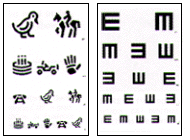Catching a moving target: eye exams in the pediatric population
To most people, an eye exam means “Which is better, 1 or 2?” And for most of my examinations, this is largely the case. A school-aged child can generally look at the choices between two lenses and tell me which one they prefer. Adults actually fret about this part of the exam quite a bit more than the kids! Adults are very worried they’ll give a “wrong” answer and end up with the wrong glasses.
Actually, to reassure the adults reading this, you should really know that it’s extremely unlikely that you will give me an answer that will lead to the wrong pair of glasses. The point of the “which is better” game is to bracket choices between lenses. For example, if I show you a lens that is much too weak, you will easily notice the difference and choose the stronger lens that makes the chart clearer. But if we’ve already found the right lens for you, and I show you one slightly stronger, you may not really see the difference between the choices. Please know that I am asking you basically the same question several times, to see the consistency of your responses, and what your visual system prefers. And I’m actually happy when we get to that lens that “looks the same” because that means we’ve bracketed correctly to the right prescription for you!
But, back to the kids who can’t sit behind the machine and answer the “Which is better question.” How can we test them?
I often examine children in pre-school or kindergarten age. Kids at this age as a general rule can’t tolerate a long, drawn out exam, and you have to work quickly to get to the glasses prescription. I usually use a trial frame, so they can move around and take the glasses off if they need a break. Trial frames look like this:
Trial frame refractions also work really well for kids who can’t sit still because of attention deficit disorder, sensory processing disorders, or autism.
What about the patient with autism who experiences extreme stress from the unfamiliar environment? An eye exam is very daunting for those children. The room is different, there is a lot of equipment that’s very scary-looking, and the eye doctor is new to them. For those patients, the exam starts in the waiting room, where I get to meet them, let them know I’m friendly and not wearing a scary, doctor-like, white lab coat. If they’re comfortable coming back to the exam room, we can move there. If not, I have actually been known to bring my equipment to the waiting room when I have to. All of the doctors in my office have been seen doing this.
Sometimes, the first visit serves to familiarize the patient with our office and with me. And, we might bring them back in a week or two to finish the exam.
What if your child doesn’t know all of her letters? What if he doesn’t know any of his letters? Well, we have several different types of eye charts that we can use. One chart is of pictures, such as an airplane, cake, handprint, horse. Or, numbers, or even E’s that tumble.
I even have a chart that uses pictures of cars. One car has wheels that are normal and the other car has wheels that are “broken.” If the child can see the difference between the wheels, we can actually use that target to measure visual acuity.
I might check eye tracking using a puppet or stickers or a toy. But, honestly, these days, asking mom or dad to take a cell phone picture of the child is usually the best way to get good eye contact so that I can measure eye movement ability.
What about the dreaded eye dilation? Everyone hates eye drops! And, sometimes it’s the parent who hates the eye drops more than the child. How do you get eye drops into the eyes of a scared child, without making them even more afraid to come back next year? I have found a technique of laying the child on the floor, asking them to squeeze their eyes together as tight as possible, and then putting the drops in the inner corner of the eyes. Then, when the child relaxes, the drops will roll in as long as we can keep the child laying on the floor for a few seconds. It works well enough to get the medication to do what I need it to do. And, maybe, just maybe it’s a wee bit less scary than prying their eyes open.
Those of us who like to do pediatric eye exams generally spend more time playing with patients on the floor than we do sitting on our exam stool! You have to be willing to go to where the patient is, and if that means they’re on the floor laying on our fluffy puppy pillow, then that’s where I’ll go.
- Dr. Cheryl Davidson




